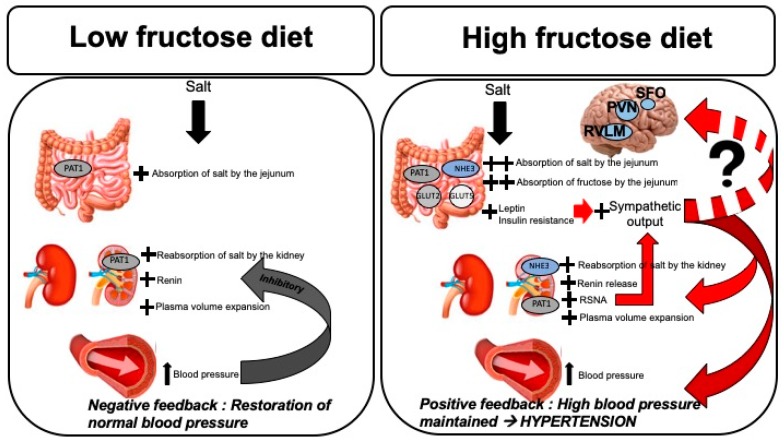Figure 1.
Mechanisms of fructose-induced salt-sensitive hypertension. Left panel: In the absence of high dietary fructose, absorption of salt in the small intestine (jejunum) and proximal tubule of the kidney is accomplished by PAT1. Increased sodium load leads to plasma volume expansion which activates RAS, resulting in elevation of blood pressure. Either increased plasma renin activity or increased blood pressure alone are capable of initiating the negative feedback mechanism to dampen NaCl reabsorption and decrease RAS activation, resulting in restoration of blood pressure back to normal. Right panel: When dietary fructose intake is high in conjunction with high salt, intestinal fructose absorption with Glut 5 and Glut 2 and sodium is absorption via PAT1 and NHE3 in increase. Proximal tubular sodium reabsorption is increased by both PAT1 and NHE3. Elevated fructose load leads to increased levels of circulating leptin and insulin, resulting in insulin resistance. These hormones lead to increased sympathetic outputs. In addition to activation of RAS and Na+ reabsorption, increased RSNA also participates in elevating blood pressure, ultimately resulting in the loss of the negative feedback mechanism. Increased afferent inputs to the central barosensitive regions may also contribute to hypertension by creating a feedforward situation via efferent sympathetic nerves. PAT1, putative anion transporter 1; NHE3, sodium/hydrogen exchanger 3; Glut 5 and Glut 2, glucose transporters 5 and 2, respectively; RAS, renin-angiotensin-aldosterone system; RSNA, renal sympathetic nerve activity; SFO, subfornical organ; PVN, paraventricular nucleus; RVLM, rostral ventrolateral medulla.

